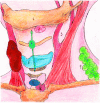Thyroglossal duct cysts and site-specific differential diagnoses: imaging findings with emphasis on ultrasound assessment
- PMID: 32052384
- PMCID: PMC7242578
- DOI: 10.1007/s40477-020-00433-2
Thyroglossal duct cysts and site-specific differential diagnoses: imaging findings with emphasis on ultrasound assessment
Abstract
Thyroglossal duct cysts (TGDCs) are the most common congenital abnormality of the neck, accounting for approximately 70% of congenital neck lesions. Two-thirds of thyroglossal duct anomalies are diagnosed within the first three decades of life, with more than half being identified before 10 years of age. The age of presentation, clinical examination and imaging are essential for an accurate diagnosis. This review aims to summarize the imaging findings of TGDCs and their main differential diagnoses with emphasis on ultrasound assessment. A focus on site-specific key differentiating between them is also addressed.
Keywords: Cystic neck lesions; Doppler techniques; Magnetic resonance imaging; Neck imaging; Neck ultrasound.
Conflict of interest statement
The authors have no conflicts of interest.
Figures










References
Publication types
MeSH terms
LinkOut - more resources
Full Text Sources

